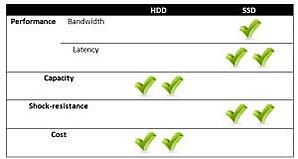This series is comparing hard disk drives (HDD) versus solid state drives (SSD) for CAD workstation storage. Read part 1 here.
Now there's no one answer that fits all when it comes to choosing any piece of hardware, so let's boil down all those distinguishing characteristics to yield some useful guidelines for outfitting your workstation's disk storage. Have high performance demands and a high budget to match, and don't demand much in the way of capacity? Go SSD. Tight on dollars and need the storage space? Go HDD, and take a look at the price delta for going to 10,000 RPM over 7,200. (And if bandwidth is really a hot button for you, check out your options for SAS — Serial Attached SCSI — which can range up to 15,000 RPM, albeit at a non-linear increase in price and reduced capacity.)
The Best of Both Worlds
There's another interesting middle ground to take in all this. Consider populating two drive bays, one with a smaller SSD and one with a big HDD. Then allocate your SSD to run your operating system and the HDD to store your models and working data. Remember that if you're fetching big, contiguous modeling data structures, latency isn't the main problem, it's bandwidth. And the difference in bandwidth between HDD and SDD isn't as significant, or at least nowhere near commensurate with the difference in price per GB. Besides, if you have a lot of model or analysis data, a 160 GB SSD isn't going to be enough, anyway. But it will be enough room for the OS, whose performance by contrast tends to be more latency sensitive, making the SSD a great fit.
What About Mobile Workstations?
If we're talking mobile workstations, there are another couple of angles to consider. First, you might be limited to one drive bay, making today's 160 GB limit for SSDs an issue. And second, your machine could really benefit from another of the SSD's major advantages I haven't yet mentioned: shock tolerance. Since there are no moving parts like the HDD's platters or drive heads, there's much less risk of bricking your machine should it take a hard fall. Both considerations make SSDs a more compelling choices for mobiles.
Ultimately, the goal in selecting any workstation component ought to be a well-balanced system, one in which there is no glaring weak link, but where all components are of comparable capabilities. And that means paying attention to the more mundane specs as well as the glitzy. Of course, zeroing in on the perfect storage subsystem that will be superior on all criteria in all situations simply isn't possible, so don't sweat it. Think about where you need capacity, where you need bandwidth and where you can tolerate latency. And most importantly, remember the budget.
There are a plenty of great choices to be had … and honestly, with the performance and prices out there, it's pretty hard to go too wrong.










